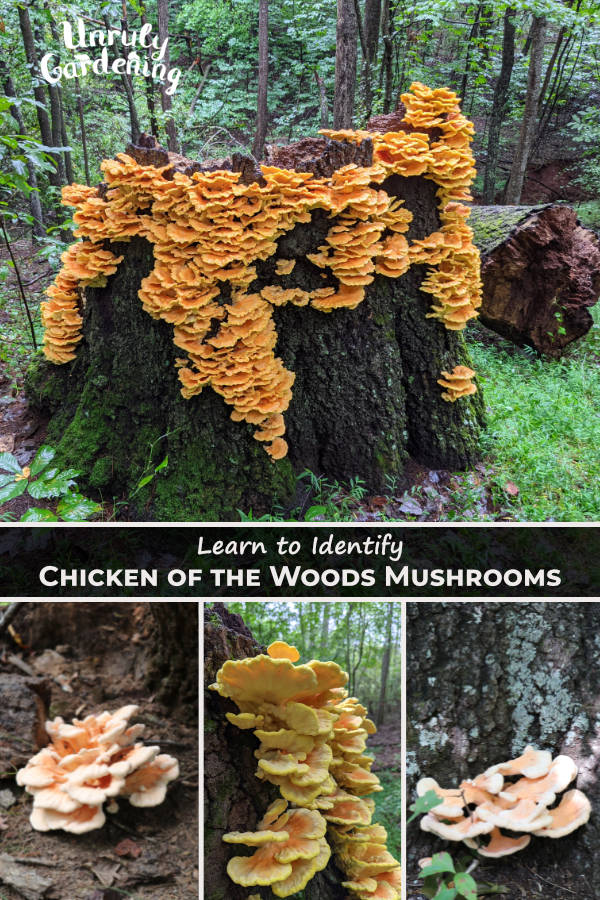Chicken of the Woods Mushroom Identification and Poisonous Look Alikes

Let's get started with identifying chicken of woods lookalikes as well as false chicken of woods. This is a critical step ensuring you harvest the correct mushrooms.
See Mushroom Identification Book
Another good book for mushroom identifying wild muhrooms - See Best-Selling Paul Stamet's Mushroom ID Book - $6 for Kindle Version
Chicken of the Woods mushroom, also known as Laetiporus sulphureus, is a tasty and popular edible mushroom that can be found in North America, Europe, and Asia. Its bright orange to yellowish color and soft texture make it a popular addition to many dishes. However, it's important to be able to identify chicken of the woods correctly to avoid the poisonous look-alikes that can cause serious harm. In this article, we will discuss some of the false chicken of the woods and other look-alikes, how to identify chicken of the woods, and the side-effects of the poisonous look-alikes.
False Chicken of the Woods:
One of the false chicken of the woods is the jack o lantern mushroom (Omphalotus illudens), which is poisonous and can cause vomiting, cramps, and diarrhea. Unlike chicken of the woods, jack o lantern mushrooms have gills instead of pores underneath their caps, and they glow in the dark. These mushrooms grow in the same habitat as chicken of the woods, often appearing in clusters on decaying wood. They are typically found from late summer to early fall.
Another false chicken of the woods is Berkeley's polypore (Bondarzewia berkeleyi), which is also poisonous and can cause gastrointestinal distress. Unlike chicken of the woods, Berkeley's polypore has a brownish-grey cap with a hairy texture, and it typically grows on the ground rather than on trees. These mushrooms are usually found in the late summer and fall.
Look-Alike Chicken of the Woods:
One of the look-alike chicken of the woods is the velvet top fungus (Trichaptum biforme). This mushroom has a similar orange color and texture to chicken of the woods, but it has a smooth cap instead of a wrinkled one. The underside of the velvet top fungus has tiny pores instead of the large, distinct pores of chicken of the woods. These mushrooms grow on hardwood trees and can be found in late summer and fall.
Another look-alike chicken of the woods is the cow of the woods mushroom (Paxillus involutus). This mushroom has a yellowish-orange color and a slightly slimy cap. Unlike chicken of the woods, cow of the woods has a stem and gills instead of pores underneath its cap. This mushroom grows on the ground and can be found in late summer and fall.
Chicken of the Woods Identification:
Chicken of the woods mushroom has a bright orange to yellowish color with a wrinkled cap and a soft, spongy texture. The underside of the cap has large, distinct pores that are bright yellow in color. Chicken of the woods grows on the side of hardwood trees, particularly oak, and can be found from late spring to early fall. It is important to note that chicken of the woods should only be harvested from healthy trees, as mushrooms growing on diseased or dead trees may contain harmful toxins.
Poisonous Chicken of the Woods Mushroom Look-Alike:
One of the most poisonous chicken of the woods mushroom look-alikes is the white chicken of the woods (Laetiporus huroniensis). This mushroom has a white to cream-colored cap with tiny pores underneath. It is typically found growing on dead or dying hardwood trees and can be found from late summer to early fall. Ingesting white chicken of the woods can cause severe gastrointestinal distress, liver damage, and even death.
In conclusion, it's crucial to know how to identify chicken of the woods and the false and poisonous look-alikes that can cause harm. Always make sure to properly identify mushrooms before consuming them and only harvest from healthy trees. When in doubt, consult an expert in mushroom identification to ensure your safety.
See Mushroom Identification Book
Another good book for mushroom identifying wild muhrooms - See Best-Selling Paul Stamet's Mushroom ID Book - $6 for Kindle Version


